Sainsbury's Leadership and Management: An Analytical Evaluation Report
VerifiedAdded on 2023/01/03
|13
|3212
|78
Report
AI Summary
This report provides a detailed analysis of Sainsbury's leadership and management approaches. It begins with an introduction that highlights the importance of leadership in influencing employees towards achieving organizational goals and the role of management in optimizing productivity. The main body includes a comparison and analysis of various leadership styles, such as participative, situational, transformative, and autocratic leadership, as well as management theories like scientific management, systems management, and contingency management. The report further examines key performance metrics, including revenue per customer, gross profit margin, organizational sales, and monthly recurring revenue. It then evaluates the performance of leadership and management within Sainsbury's, highlighting their direct impact on organizational outcomes and comparing leadership and management roles. The report concludes with a summary of findings and implications, supported by cited references.
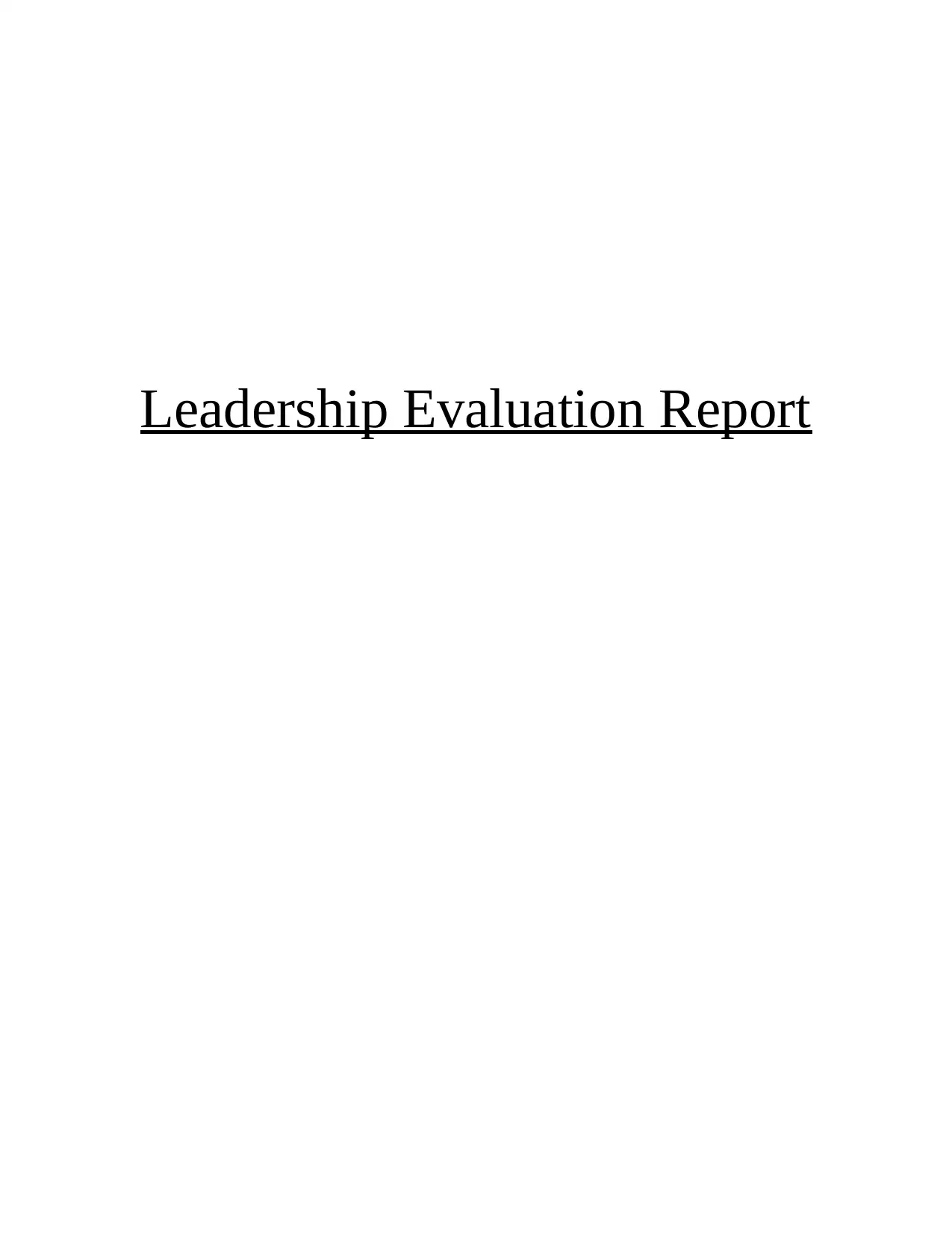
Leadership Evaluation Report
Paraphrase This Document
Need a fresh take? Get an instant paraphrase of this document with our AI Paraphraser
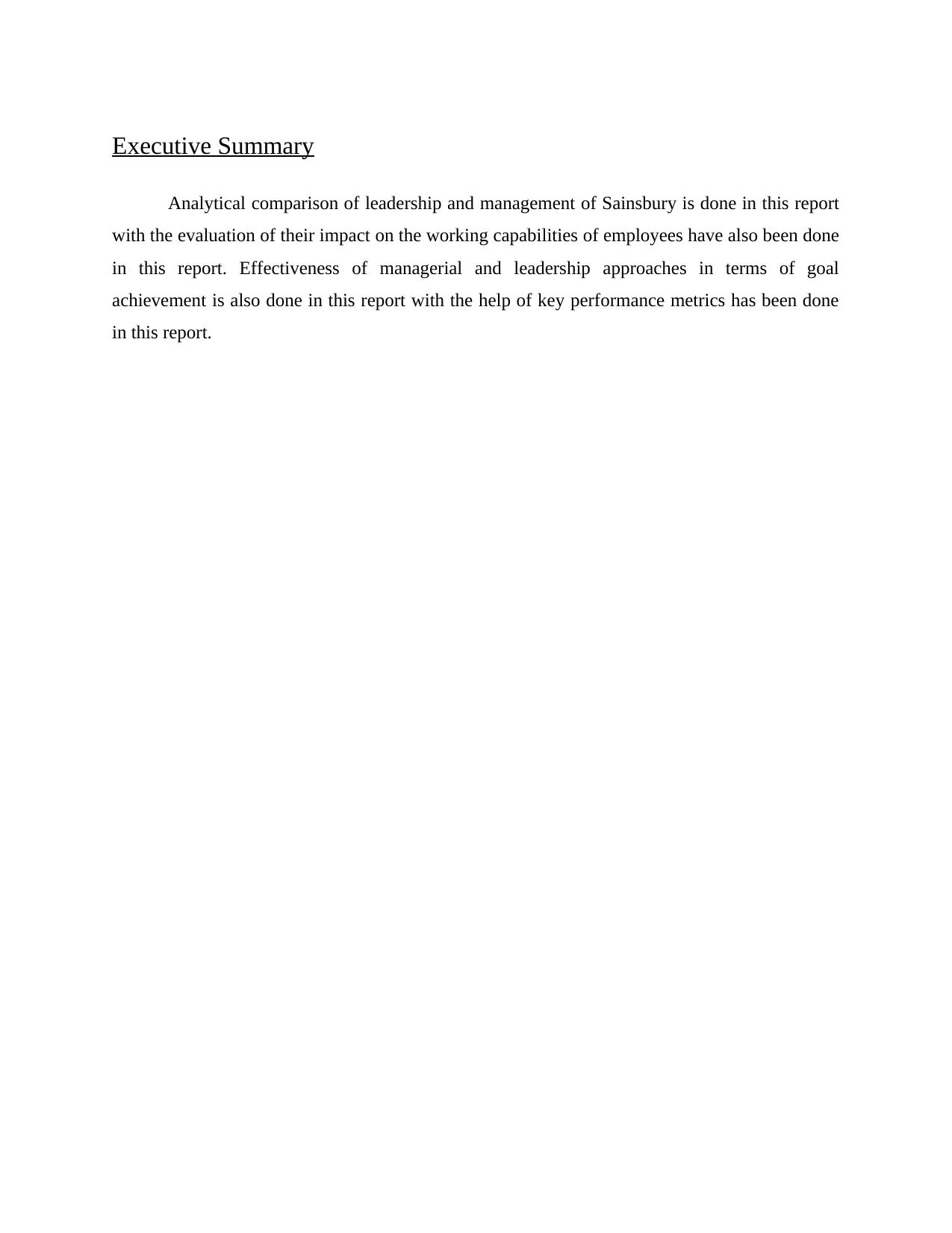
Executive Summary
Analytical comparison of leadership and management of Sainsbury is done in this report
with the evaluation of their impact on the working capabilities of employees have also been done
in this report. Effectiveness of managerial and leadership approaches in terms of goal
achievement is also done in this report with the help of key performance metrics has been done
in this report.
Analytical comparison of leadership and management of Sainsbury is done in this report
with the evaluation of their impact on the working capabilities of employees have also been done
in this report. Effectiveness of managerial and leadership approaches in terms of goal
achievement is also done in this report with the help of key performance metrics has been done
in this report.
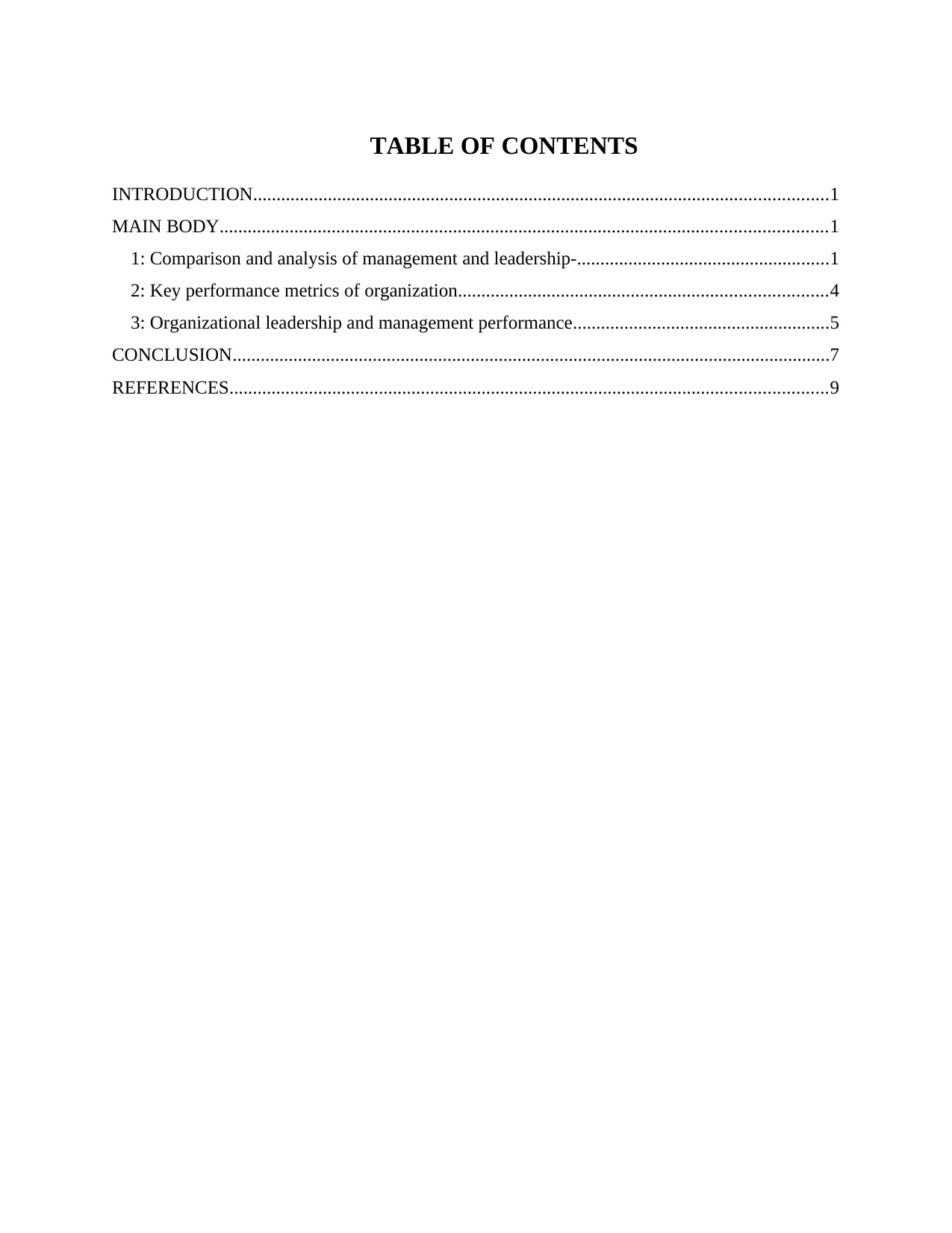
TABLE OF CONTENTS
INTRODUCTION...........................................................................................................................1
MAIN BODY..................................................................................................................................1
1: Comparison and analysis of management and leadership-......................................................1
2: Key performance metrics of organization...............................................................................4
3: Organizational leadership and management performance.......................................................5
CONCLUSION................................................................................................................................7
REFERENCES................................................................................................................................9
INTRODUCTION...........................................................................................................................1
MAIN BODY..................................................................................................................................1
1: Comparison and analysis of management and leadership-......................................................1
2: Key performance metrics of organization...............................................................................4
3: Organizational leadership and management performance.......................................................5
CONCLUSION................................................................................................................................7
REFERENCES................................................................................................................................9
⊘ This is a preview!⊘
Do you want full access?
Subscribe today to unlock all pages.

Trusted by 1+ million students worldwide
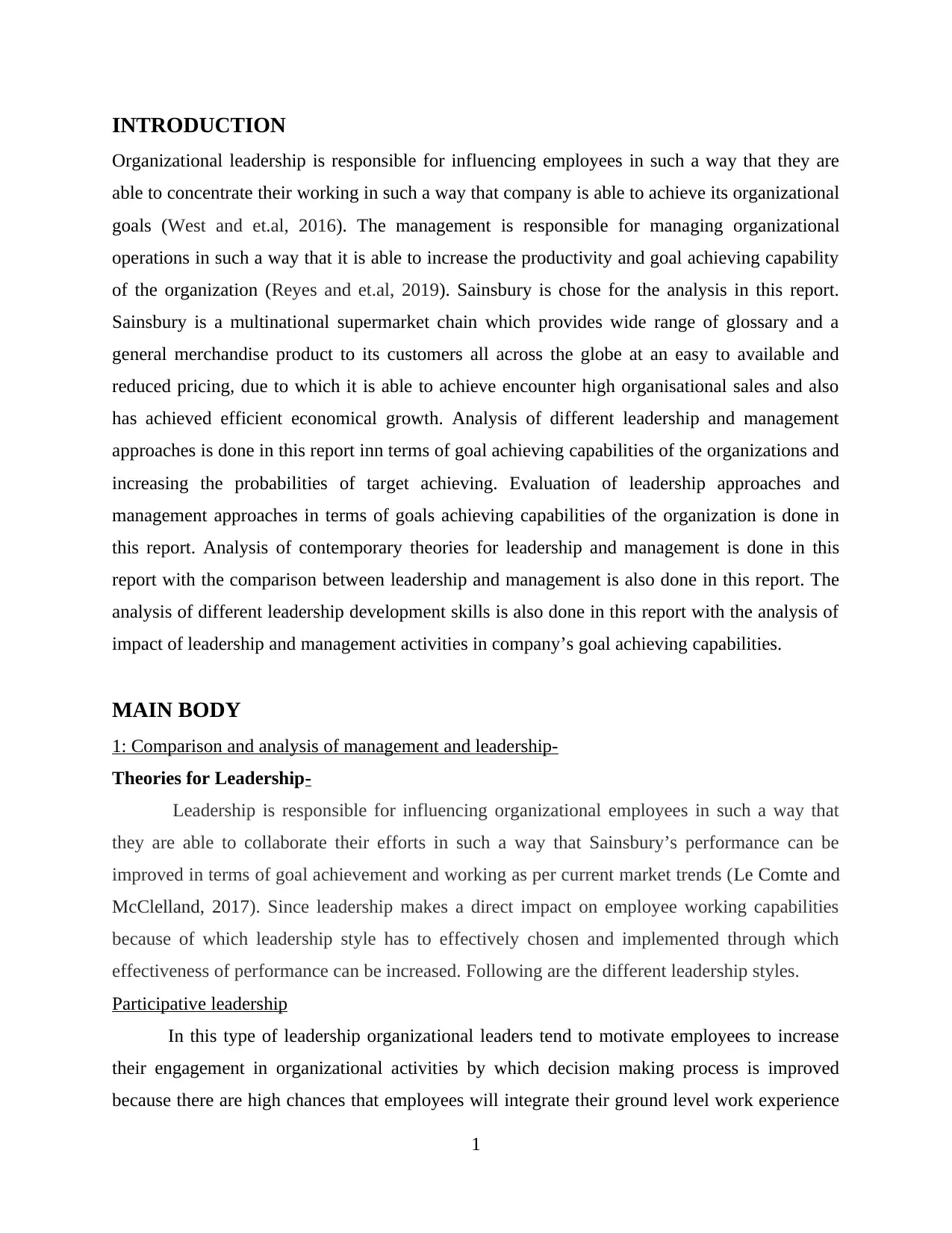
INTRODUCTION
Organizational leadership is responsible for influencing employees in such a way that they are
able to concentrate their working in such a way that company is able to achieve its organizational
goals (West and et.al, 2016). The management is responsible for managing organizational
operations in such a way that it is able to increase the productivity and goal achieving capability
of the organization (Reyes and et.al, 2019). Sainsbury is chose for the analysis in this report.
Sainsbury is a multinational supermarket chain which provides wide range of glossary and a
general merchandise product to its customers all across the globe at an easy to available and
reduced pricing, due to which it is able to achieve encounter high organisational sales and also
has achieved efficient economical growth. Analysis of different leadership and management
approaches is done in this report inn terms of goal achieving capabilities of the organizations and
increasing the probabilities of target achieving. Evaluation of leadership approaches and
management approaches in terms of goals achieving capabilities of the organization is done in
this report. Analysis of contemporary theories for leadership and management is done in this
report with the comparison between leadership and management is also done in this report. The
analysis of different leadership development skills is also done in this report with the analysis of
impact of leadership and management activities in company’s goal achieving capabilities.
MAIN BODY
1: Comparison and analysis of management and leadership-
Theories for Leadership-
Leadership is responsible for influencing organizational employees in such a way that
they are able to collaborate their efforts in such a way that Sainsbury’s performance can be
improved in terms of goal achievement and working as per current market trends (Le Comte and
McClelland, 2017). Since leadership makes a direct impact on employee working capabilities
because of which leadership style has to effectively chosen and implemented through which
effectiveness of performance can be increased. Following are the different leadership styles.
Participative leadership
In this type of leadership organizational leaders tend to motivate employees to increase
their engagement in organizational activities by which decision making process is improved
because there are high chances that employees will integrate their ground level work experience
1
Organizational leadership is responsible for influencing employees in such a way that they are
able to concentrate their working in such a way that company is able to achieve its organizational
goals (West and et.al, 2016). The management is responsible for managing organizational
operations in such a way that it is able to increase the productivity and goal achieving capability
of the organization (Reyes and et.al, 2019). Sainsbury is chose for the analysis in this report.
Sainsbury is a multinational supermarket chain which provides wide range of glossary and a
general merchandise product to its customers all across the globe at an easy to available and
reduced pricing, due to which it is able to achieve encounter high organisational sales and also
has achieved efficient economical growth. Analysis of different leadership and management
approaches is done in this report inn terms of goal achieving capabilities of the organizations and
increasing the probabilities of target achieving. Evaluation of leadership approaches and
management approaches in terms of goals achieving capabilities of the organization is done in
this report. Analysis of contemporary theories for leadership and management is done in this
report with the comparison between leadership and management is also done in this report. The
analysis of different leadership development skills is also done in this report with the analysis of
impact of leadership and management activities in company’s goal achieving capabilities.
MAIN BODY
1: Comparison and analysis of management and leadership-
Theories for Leadership-
Leadership is responsible for influencing organizational employees in such a way that
they are able to collaborate their efforts in such a way that Sainsbury’s performance can be
improved in terms of goal achievement and working as per current market trends (Le Comte and
McClelland, 2017). Since leadership makes a direct impact on employee working capabilities
because of which leadership style has to effectively chosen and implemented through which
effectiveness of performance can be increased. Following are the different leadership styles.
Participative leadership
In this type of leadership organizational leaders tend to motivate employees to increase
their engagement in organizational activities by which decision making process is improved
because there are high chances that employees will integrate their ground level work experience
1
Paraphrase This Document
Need a fresh take? Get an instant paraphrase of this document with our AI Paraphraser
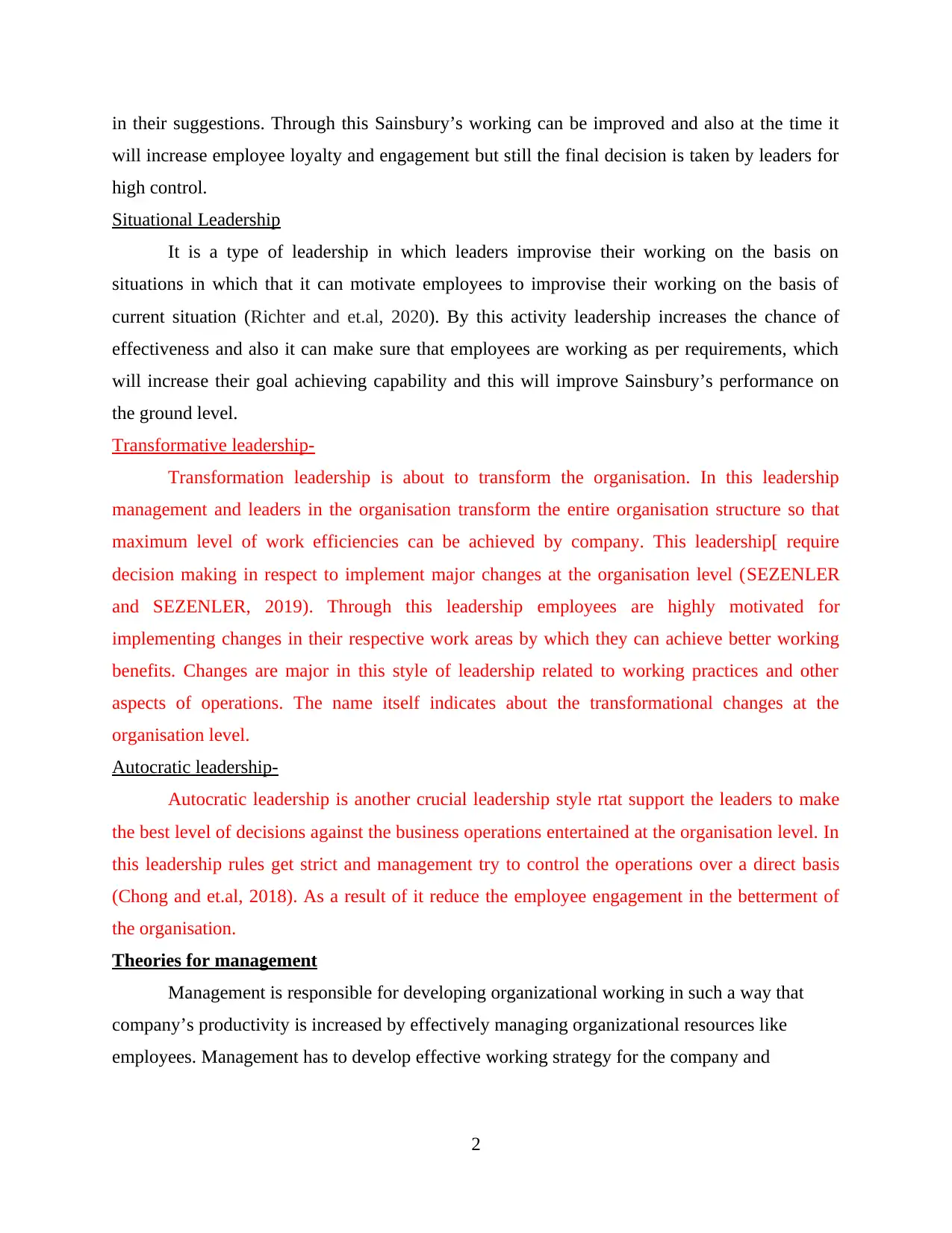
in their suggestions. Through this Sainsbury’s working can be improved and also at the time it
will increase employee loyalty and engagement but still the final decision is taken by leaders for
high control.
Situational Leadership
It is a type of leadership in which leaders improvise their working on the basis on
situations in which that it can motivate employees to improvise their working on the basis of
current situation (Richter and et.al, 2020). By this activity leadership increases the chance of
effectiveness and also it can make sure that employees are working as per requirements, which
will increase their goal achieving capability and this will improve Sainsbury’s performance on
the ground level.
Transformative leadership-
Transformation leadership is about to transform the organisation. In this leadership
management and leaders in the organisation transform the entire organisation structure so that
maximum level of work efficiencies can be achieved by company. This leadership[ require
decision making in respect to implement major changes at the organisation level (SEZENLER
and SEZENLER, 2019). Through this leadership employees are highly motivated for
implementing changes in their respective work areas by which they can achieve better working
benefits. Changes are major in this style of leadership related to working practices and other
aspects of operations. The name itself indicates about the transformational changes at the
organisation level.
Autocratic leadership-
Autocratic leadership is another crucial leadership style rtat support the leaders to make
the best level of decisions against the business operations entertained at the organisation level. In
this leadership rules get strict and management try to control the operations over a direct basis
(Chong and et.al, 2018). As a result of it reduce the employee engagement in the betterment of
the organisation.
Theories for management
Management is responsible for developing organizational working in such a way that
company’s productivity is increased by effectively managing organizational resources like
employees. Management has to develop effective working strategy for the company and
2
will increase employee loyalty and engagement but still the final decision is taken by leaders for
high control.
Situational Leadership
It is a type of leadership in which leaders improvise their working on the basis on
situations in which that it can motivate employees to improvise their working on the basis of
current situation (Richter and et.al, 2020). By this activity leadership increases the chance of
effectiveness and also it can make sure that employees are working as per requirements, which
will increase their goal achieving capability and this will improve Sainsbury’s performance on
the ground level.
Transformative leadership-
Transformation leadership is about to transform the organisation. In this leadership
management and leaders in the organisation transform the entire organisation structure so that
maximum level of work efficiencies can be achieved by company. This leadership[ require
decision making in respect to implement major changes at the organisation level (SEZENLER
and SEZENLER, 2019). Through this leadership employees are highly motivated for
implementing changes in their respective work areas by which they can achieve better working
benefits. Changes are major in this style of leadership related to working practices and other
aspects of operations. The name itself indicates about the transformational changes at the
organisation level.
Autocratic leadership-
Autocratic leadership is another crucial leadership style rtat support the leaders to make
the best level of decisions against the business operations entertained at the organisation level. In
this leadership rules get strict and management try to control the operations over a direct basis
(Chong and et.al, 2018). As a result of it reduce the employee engagement in the betterment of
the organisation.
Theories for management
Management is responsible for developing organizational working in such a way that
company’s productivity is increased by effectively managing organizational resources like
employees. Management has to develop effective working strategy for the company and
2
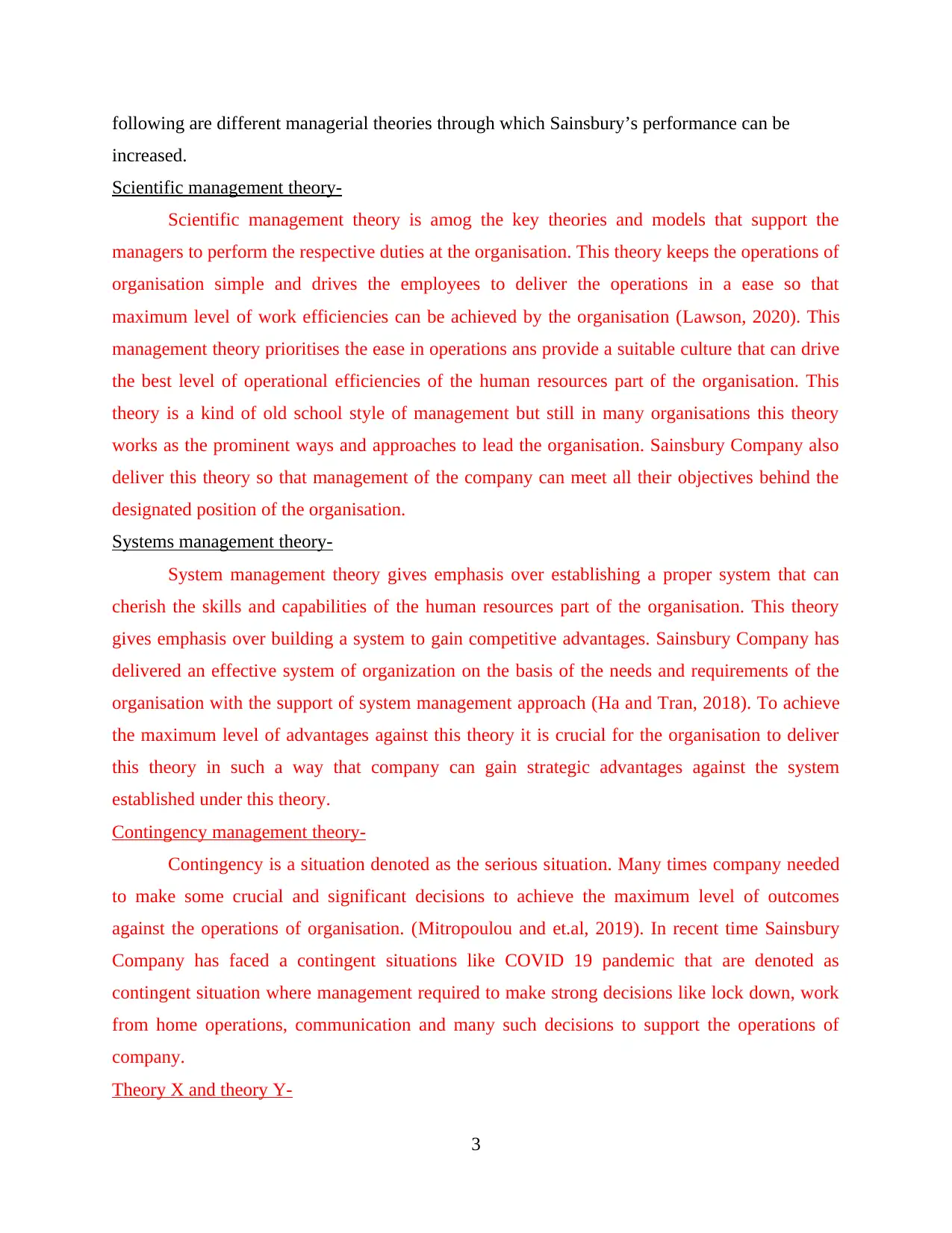
following are different managerial theories through which Sainsbury’s performance can be
increased.
Scientific management theory-
Scientific management theory is amog the key theories and models that support the
managers to perform the respective duties at the organisation. This theory keeps the operations of
organisation simple and drives the employees to deliver the operations in a ease so that
maximum level of work efficiencies can be achieved by the organisation (Lawson, 2020). This
management theory prioritises the ease in operations ans provide a suitable culture that can drive
the best level of operational efficiencies of the human resources part of the organisation. This
theory is a kind of old school style of management but still in many organisations this theory
works as the prominent ways and approaches to lead the organisation. Sainsbury Company also
deliver this theory so that management of the company can meet all their objectives behind the
designated position of the organisation.
Systems management theory-
System management theory gives emphasis over establishing a proper system that can
cherish the skills and capabilities of the human resources part of the organisation. This theory
gives emphasis over building a system to gain competitive advantages. Sainsbury Company has
delivered an effective system of organization on the basis of the needs and requirements of the
organisation with the support of system management approach (Ha and Tran, 2018). To achieve
the maximum level of advantages against this theory it is crucial for the organisation to deliver
this theory in such a way that company can gain strategic advantages against the system
established under this theory.
Contingency management theory-
Contingency is a situation denoted as the serious situation. Many times company needed
to make some crucial and significant decisions to achieve the maximum level of outcomes
against the operations of organisation. (Mitropoulou and et.al, 2019). In recent time Sainsbury
Company has faced a contingent situations like COVID 19 pandemic that are denoted as
contingent situation where management required to make strong decisions like lock down, work
from home operations, communication and many such decisions to support the operations of
company.
Theory X and theory Y-
3
increased.
Scientific management theory-
Scientific management theory is amog the key theories and models that support the
managers to perform the respective duties at the organisation. This theory keeps the operations of
organisation simple and drives the employees to deliver the operations in a ease so that
maximum level of work efficiencies can be achieved by the organisation (Lawson, 2020). This
management theory prioritises the ease in operations ans provide a suitable culture that can drive
the best level of operational efficiencies of the human resources part of the organisation. This
theory is a kind of old school style of management but still in many organisations this theory
works as the prominent ways and approaches to lead the organisation. Sainsbury Company also
deliver this theory so that management of the company can meet all their objectives behind the
designated position of the organisation.
Systems management theory-
System management theory gives emphasis over establishing a proper system that can
cherish the skills and capabilities of the human resources part of the organisation. This theory
gives emphasis over building a system to gain competitive advantages. Sainsbury Company has
delivered an effective system of organization on the basis of the needs and requirements of the
organisation with the support of system management approach (Ha and Tran, 2018). To achieve
the maximum level of advantages against this theory it is crucial for the organisation to deliver
this theory in such a way that company can gain strategic advantages against the system
established under this theory.
Contingency management theory-
Contingency is a situation denoted as the serious situation. Many times company needed
to make some crucial and significant decisions to achieve the maximum level of outcomes
against the operations of organisation. (Mitropoulou and et.al, 2019). In recent time Sainsbury
Company has faced a contingent situations like COVID 19 pandemic that are denoted as
contingent situation where management required to make strong decisions like lock down, work
from home operations, communication and many such decisions to support the operations of
company.
Theory X and theory Y-
3
⊘ This is a preview!⊘
Do you want full access?
Subscribe today to unlock all pages.

Trusted by 1+ million students worldwide
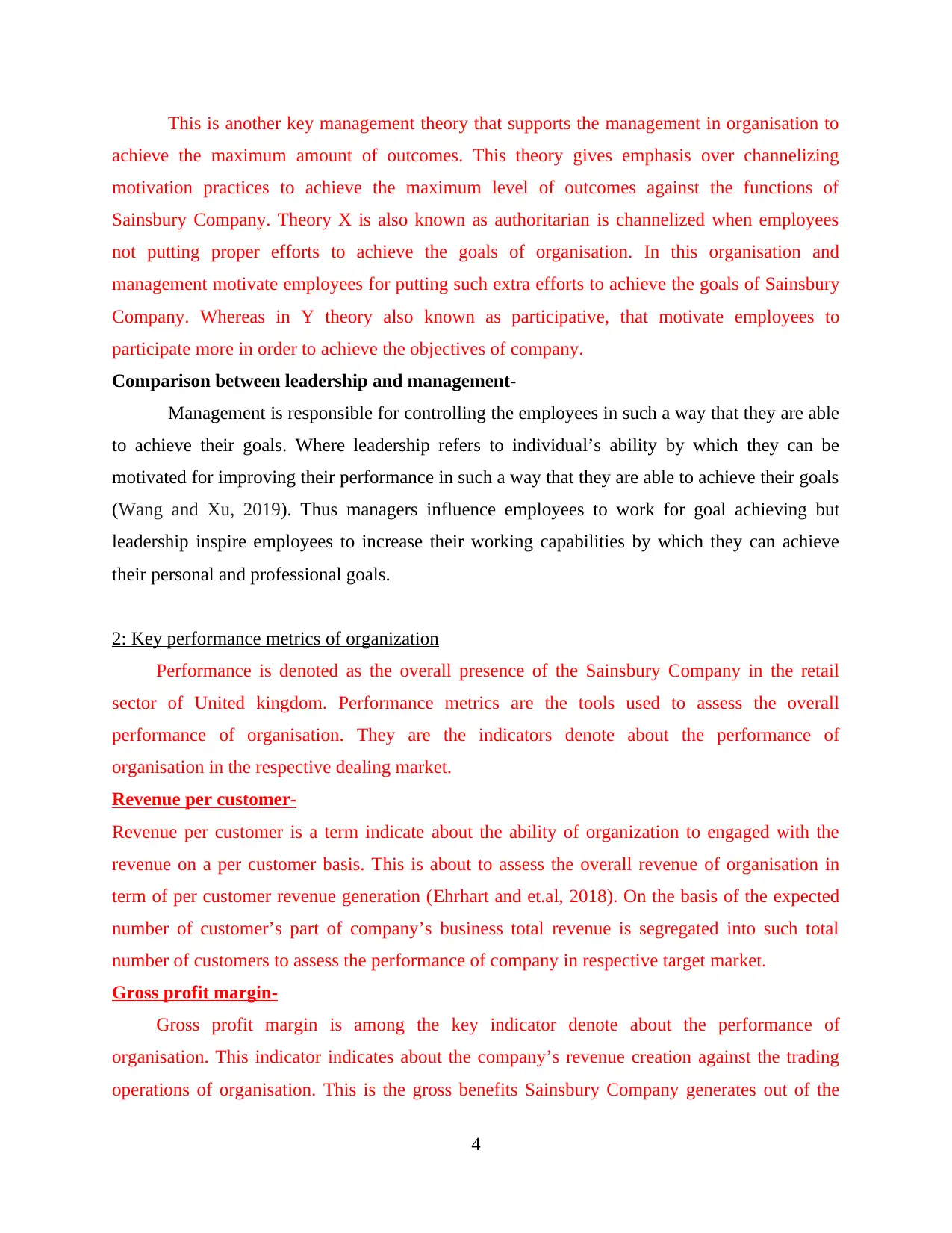
This is another key management theory that supports the management in organisation to
achieve the maximum amount of outcomes. This theory gives emphasis over channelizing
motivation practices to achieve the maximum level of outcomes against the functions of
Sainsbury Company. Theory X is also known as authoritarian is channelized when employees
not putting proper efforts to achieve the goals of organisation. In this organisation and
management motivate employees for putting such extra efforts to achieve the goals of Sainsbury
Company. Whereas in Y theory also known as participative, that motivate employees to
participate more in order to achieve the objectives of company.
Comparison between leadership and management-
Management is responsible for controlling the employees in such a way that they are able
to achieve their goals. Where leadership refers to individual’s ability by which they can be
motivated for improving their performance in such a way that they are able to achieve their goals
(Wang and Xu, 2019). Thus managers influence employees to work for goal achieving but
leadership inspire employees to increase their working capabilities by which they can achieve
their personal and professional goals.
2: Key performance metrics of organization
Performance is denoted as the overall presence of the Sainsbury Company in the retail
sector of United kingdom. Performance metrics are the tools used to assess the overall
performance of organisation. They are the indicators denote about the performance of
organisation in the respective dealing market.
Revenue per customer-
Revenue per customer is a term indicate about the ability of organization to engaged with the
revenue on a per customer basis. This is about to assess the overall revenue of organisation in
term of per customer revenue generation (Ehrhart and et.al, 2018). On the basis of the expected
number of customer’s part of company’s business total revenue is segregated into such total
number of customers to assess the performance of company in respective target market.
Gross profit margin-
Gross profit margin is among the key indicator denote about the performance of
organisation. This indicator indicates about the company’s revenue creation against the trading
operations of organisation. This is the gross benefits Sainsbury Company generates out of the
4
achieve the maximum amount of outcomes. This theory gives emphasis over channelizing
motivation practices to achieve the maximum level of outcomes against the functions of
Sainsbury Company. Theory X is also known as authoritarian is channelized when employees
not putting proper efforts to achieve the goals of organisation. In this organisation and
management motivate employees for putting such extra efforts to achieve the goals of Sainsbury
Company. Whereas in Y theory also known as participative, that motivate employees to
participate more in order to achieve the objectives of company.
Comparison between leadership and management-
Management is responsible for controlling the employees in such a way that they are able
to achieve their goals. Where leadership refers to individual’s ability by which they can be
motivated for improving their performance in such a way that they are able to achieve their goals
(Wang and Xu, 2019). Thus managers influence employees to work for goal achieving but
leadership inspire employees to increase their working capabilities by which they can achieve
their personal and professional goals.
2: Key performance metrics of organization
Performance is denoted as the overall presence of the Sainsbury Company in the retail
sector of United kingdom. Performance metrics are the tools used to assess the overall
performance of organisation. They are the indicators denote about the performance of
organisation in the respective dealing market.
Revenue per customer-
Revenue per customer is a term indicate about the ability of organization to engaged with the
revenue on a per customer basis. This is about to assess the overall revenue of organisation in
term of per customer revenue generation (Ehrhart and et.al, 2018). On the basis of the expected
number of customer’s part of company’s business total revenue is segregated into such total
number of customers to assess the performance of company in respective target market.
Gross profit margin-
Gross profit margin is among the key indicator denote about the performance of
organisation. This indicator indicates about the company’s revenue creation against the trading
operations of organisation. This is the gross benefits Sainsbury Company generates out of the
4
Paraphrase This Document
Need a fresh take? Get an instant paraphrase of this document with our AI Paraphraser
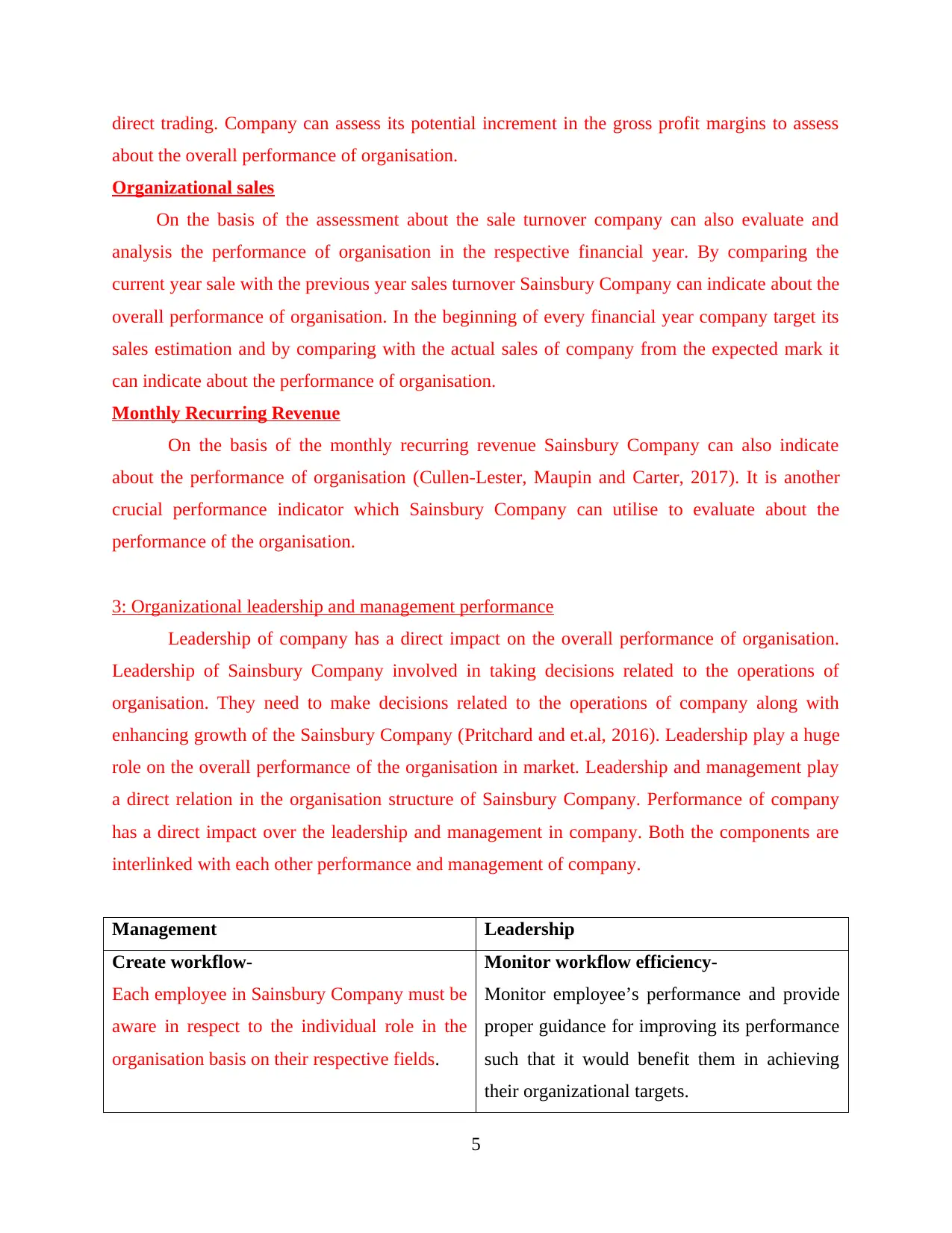
direct trading. Company can assess its potential increment in the gross profit margins to assess
about the overall performance of organisation.
Organizational sales
On the basis of the assessment about the sale turnover company can also evaluate and
analysis the performance of organisation in the respective financial year. By comparing the
current year sale with the previous year sales turnover Sainsbury Company can indicate about the
overall performance of organisation. In the beginning of every financial year company target its
sales estimation and by comparing with the actual sales of company from the expected mark it
can indicate about the performance of organisation.
Monthly Recurring Revenue
On the basis of the monthly recurring revenue Sainsbury Company can also indicate
about the performance of organisation (Cullen-Lester, Maupin and Carter, 2017). It is another
crucial performance indicator which Sainsbury Company can utilise to evaluate about the
performance of the organisation.
3: Organizational leadership and management performance
Leadership of company has a direct impact on the overall performance of organisation.
Leadership of Sainsbury Company involved in taking decisions related to the operations of
organisation. They need to make decisions related to the operations of company along with
enhancing growth of the Sainsbury Company (Pritchard and et.al, 2016). Leadership play a huge
role on the overall performance of the organisation in market. Leadership and management play
a direct relation in the organisation structure of Sainsbury Company. Performance of company
has a direct impact over the leadership and management in company. Both the components are
interlinked with each other performance and management of company.
Management Leadership
Create workflow-
Each employee in Sainsbury Company must be
aware in respect to the individual role in the
organisation basis on their respective fields.
Monitor workflow efficiency-
Monitor employee’s performance and provide
proper guidance for improving its performance
such that it would benefit them in achieving
their organizational targets.
5
about the overall performance of organisation.
Organizational sales
On the basis of the assessment about the sale turnover company can also evaluate and
analysis the performance of organisation in the respective financial year. By comparing the
current year sale with the previous year sales turnover Sainsbury Company can indicate about the
overall performance of organisation. In the beginning of every financial year company target its
sales estimation and by comparing with the actual sales of company from the expected mark it
can indicate about the performance of organisation.
Monthly Recurring Revenue
On the basis of the monthly recurring revenue Sainsbury Company can also indicate
about the performance of organisation (Cullen-Lester, Maupin and Carter, 2017). It is another
crucial performance indicator which Sainsbury Company can utilise to evaluate about the
performance of the organisation.
3: Organizational leadership and management performance
Leadership of company has a direct impact on the overall performance of organisation.
Leadership of Sainsbury Company involved in taking decisions related to the operations of
organisation. They need to make decisions related to the operations of company along with
enhancing growth of the Sainsbury Company (Pritchard and et.al, 2016). Leadership play a huge
role on the overall performance of the organisation in market. Leadership and management play
a direct relation in the organisation structure of Sainsbury Company. Performance of company
has a direct impact over the leadership and management in company. Both the components are
interlinked with each other performance and management of company.
Management Leadership
Create workflow-
Each employee in Sainsbury Company must be
aware in respect to the individual role in the
organisation basis on their respective fields.
Monitor workflow efficiency-
Monitor employee’s performance and provide
proper guidance for improving its performance
such that it would benefit them in achieving
their organizational targets.
5
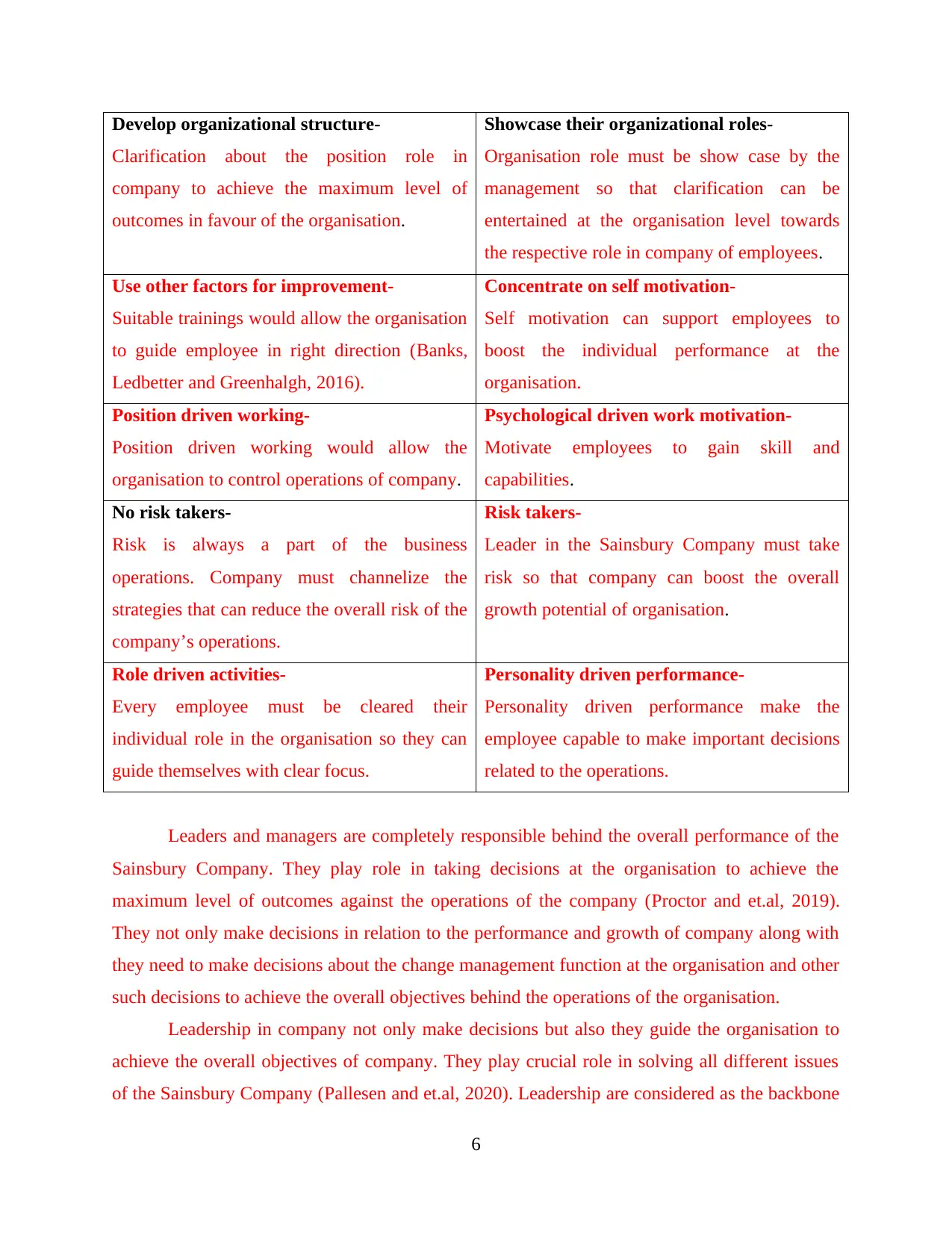
Develop organizational structure-
Clarification about the position role in
company to achieve the maximum level of
outcomes in favour of the organisation.
Showcase their organizational roles-
Organisation role must be show case by the
management so that clarification can be
entertained at the organisation level towards
the respective role in company of employees.
Use other factors for improvement-
Suitable trainings would allow the organisation
to guide employee in right direction (Banks,
Ledbetter and Greenhalgh, 2016).
Concentrate on self motivation-
Self motivation can support employees to
boost the individual performance at the
organisation.
Position driven working-
Position driven working would allow the
organisation to control operations of company.
Psychological driven work motivation-
Motivate employees to gain skill and
capabilities.
No risk takers-
Risk is always a part of the business
operations. Company must channelize the
strategies that can reduce the overall risk of the
company’s operations.
Risk takers-
Leader in the Sainsbury Company must take
risk so that company can boost the overall
growth potential of organisation.
Role driven activities-
Every employee must be cleared their
individual role in the organisation so they can
guide themselves with clear focus.
Personality driven performance-
Personality driven performance make the
employee capable to make important decisions
related to the operations.
Leaders and managers are completely responsible behind the overall performance of the
Sainsbury Company. They play role in taking decisions at the organisation to achieve the
maximum level of outcomes against the operations of the company (Proctor and et.al, 2019).
They not only make decisions in relation to the performance and growth of company along with
they need to make decisions about the change management function at the organisation and other
such decisions to achieve the overall objectives behind the operations of the organisation.
Leadership in company not only make decisions but also they guide the organisation to
achieve the overall objectives of company. They play crucial role in solving all different issues
of the Sainsbury Company (Pallesen and et.al, 2020). Leadership are considered as the backbone
6
Clarification about the position role in
company to achieve the maximum level of
outcomes in favour of the organisation.
Showcase their organizational roles-
Organisation role must be show case by the
management so that clarification can be
entertained at the organisation level towards
the respective role in company of employees.
Use other factors for improvement-
Suitable trainings would allow the organisation
to guide employee in right direction (Banks,
Ledbetter and Greenhalgh, 2016).
Concentrate on self motivation-
Self motivation can support employees to
boost the individual performance at the
organisation.
Position driven working-
Position driven working would allow the
organisation to control operations of company.
Psychological driven work motivation-
Motivate employees to gain skill and
capabilities.
No risk takers-
Risk is always a part of the business
operations. Company must channelize the
strategies that can reduce the overall risk of the
company’s operations.
Risk takers-
Leader in the Sainsbury Company must take
risk so that company can boost the overall
growth potential of organisation.
Role driven activities-
Every employee must be cleared their
individual role in the organisation so they can
guide themselves with clear focus.
Personality driven performance-
Personality driven performance make the
employee capable to make important decisions
related to the operations.
Leaders and managers are completely responsible behind the overall performance of the
Sainsbury Company. They play role in taking decisions at the organisation to achieve the
maximum level of outcomes against the operations of the company (Proctor and et.al, 2019).
They not only make decisions in relation to the performance and growth of company along with
they need to make decisions about the change management function at the organisation and other
such decisions to achieve the overall objectives behind the operations of the organisation.
Leadership in company not only make decisions but also they guide the organisation to
achieve the overall objectives of company. They play crucial role in solving all different issues
of the Sainsbury Company (Pallesen and et.al, 2020). Leadership are considered as the backbone
6
⊘ This is a preview!⊘
Do you want full access?
Subscribe today to unlock all pages.

Trusted by 1+ million students worldwide
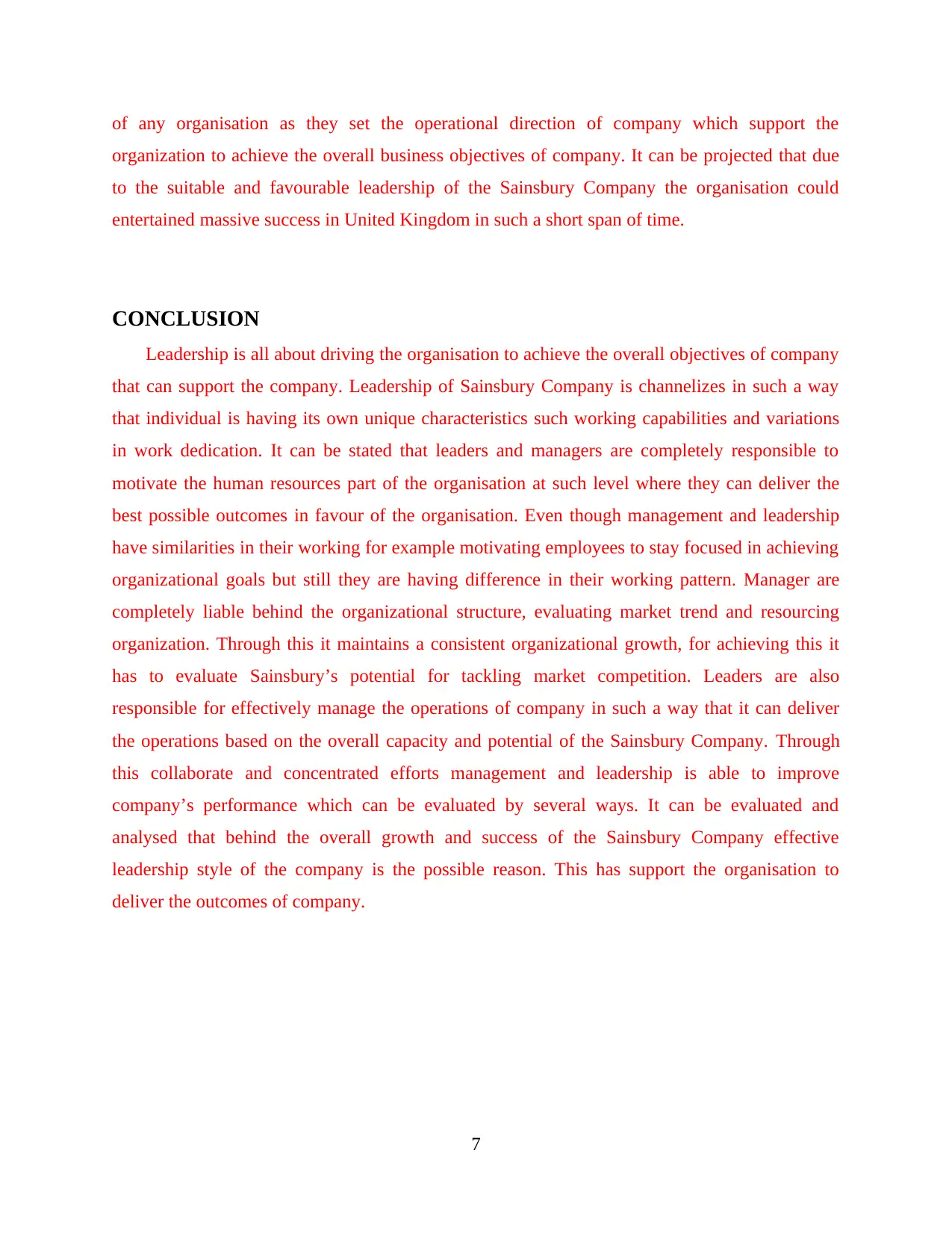
of any organisation as they set the operational direction of company which support the
organization to achieve the overall business objectives of company. It can be projected that due
to the suitable and favourable leadership of the Sainsbury Company the organisation could
entertained massive success in United Kingdom in such a short span of time.
CONCLUSION
Leadership is all about driving the organisation to achieve the overall objectives of company
that can support the company. Leadership of Sainsbury Company is channelizes in such a way
that individual is having its own unique characteristics such working capabilities and variations
in work dedication. It can be stated that leaders and managers are completely responsible to
motivate the human resources part of the organisation at such level where they can deliver the
best possible outcomes in favour of the organisation. Even though management and leadership
have similarities in their working for example motivating employees to stay focused in achieving
organizational goals but still they are having difference in their working pattern. Manager are
completely liable behind the organizational structure, evaluating market trend and resourcing
organization. Through this it maintains a consistent organizational growth, for achieving this it
has to evaluate Sainsbury’s potential for tackling market competition. Leaders are also
responsible for effectively manage the operations of company in such a way that it can deliver
the operations based on the overall capacity and potential of the Sainsbury Company. Through
this collaborate and concentrated efforts management and leadership is able to improve
company’s performance which can be evaluated by several ways. It can be evaluated and
analysed that behind the overall growth and success of the Sainsbury Company effective
leadership style of the company is the possible reason. This has support the organisation to
deliver the outcomes of company.
7
organization to achieve the overall business objectives of company. It can be projected that due
to the suitable and favourable leadership of the Sainsbury Company the organisation could
entertained massive success in United Kingdom in such a short span of time.
CONCLUSION
Leadership is all about driving the organisation to achieve the overall objectives of company
that can support the company. Leadership of Sainsbury Company is channelizes in such a way
that individual is having its own unique characteristics such working capabilities and variations
in work dedication. It can be stated that leaders and managers are completely responsible to
motivate the human resources part of the organisation at such level where they can deliver the
best possible outcomes in favour of the organisation. Even though management and leadership
have similarities in their working for example motivating employees to stay focused in achieving
organizational goals but still they are having difference in their working pattern. Manager are
completely liable behind the organizational structure, evaluating market trend and resourcing
organization. Through this it maintains a consistent organizational growth, for achieving this it
has to evaluate Sainsbury’s potential for tackling market competition. Leaders are also
responsible for effectively manage the operations of company in such a way that it can deliver
the operations based on the overall capacity and potential of the Sainsbury Company. Through
this collaborate and concentrated efforts management and leadership is able to improve
company’s performance which can be evaluated by several ways. It can be evaluated and
analysed that behind the overall growth and success of the Sainsbury Company effective
leadership style of the company is the possible reason. This has support the organisation to
deliver the outcomes of company.
7
Paraphrase This Document
Need a fresh take? Get an instant paraphrase of this document with our AI Paraphraser
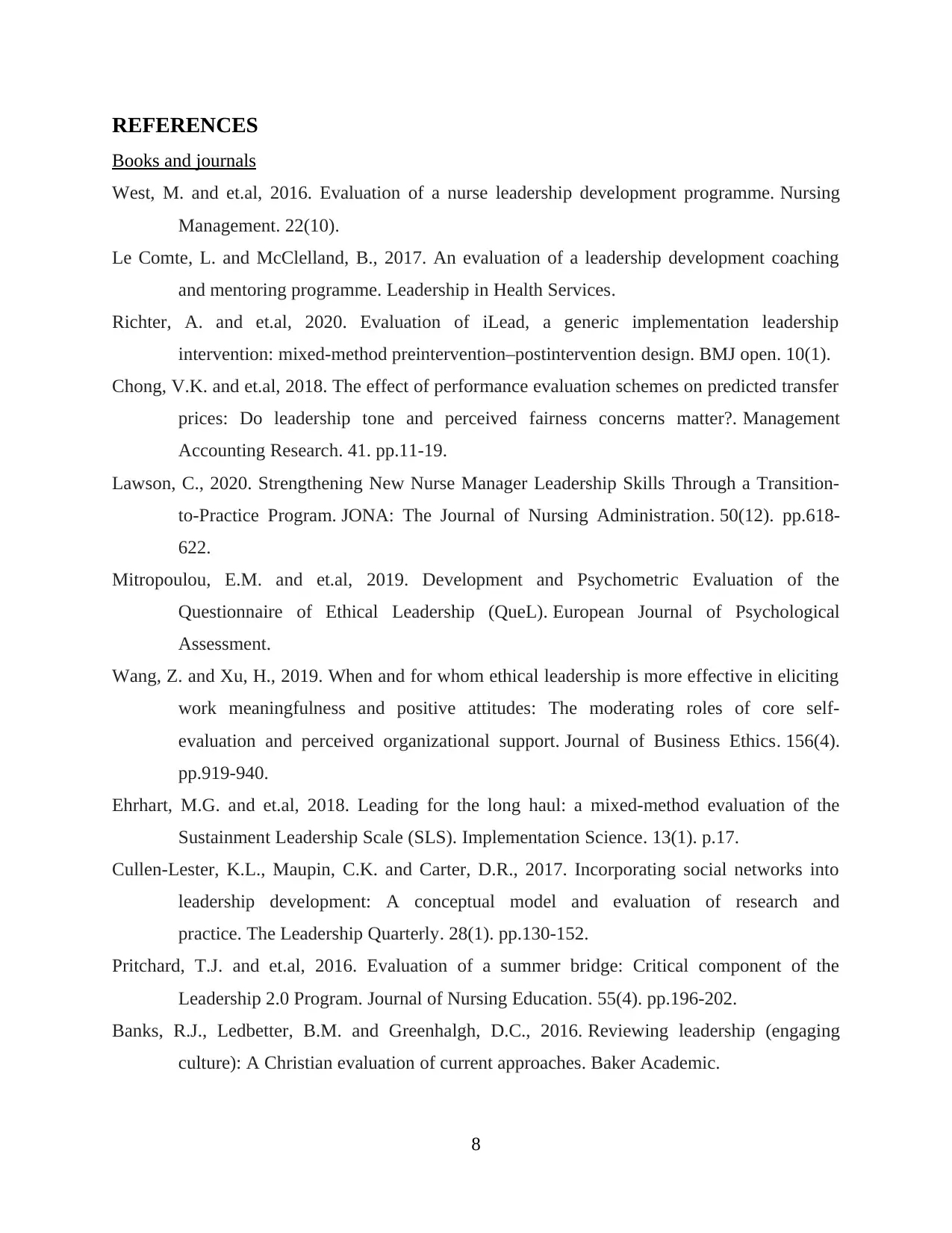
REFERENCES
Books and journals
West, M. and et.al, 2016. Evaluation of a nurse leadership development programme. Nursing
Management. 22(10).
Le Comte, L. and McClelland, B., 2017. An evaluation of a leadership development coaching
and mentoring programme. Leadership in Health Services.
Richter, A. and et.al, 2020. Evaluation of iLead, a generic implementation leadership
intervention: mixed-method preintervention–postintervention design. BMJ open. 10(1).
Chong, V.K. and et.al, 2018. The effect of performance evaluation schemes on predicted transfer
prices: Do leadership tone and perceived fairness concerns matter?. Management
Accounting Research. 41. pp.11-19.
Lawson, C., 2020. Strengthening New Nurse Manager Leadership Skills Through a Transition-
to-Practice Program. JONA: The Journal of Nursing Administration. 50(12). pp.618-
622.
Mitropoulou, E.M. and et.al, 2019. Development and Psychometric Evaluation of the
Questionnaire of Ethical Leadership (QueL). European Journal of Psychological
Assessment.
Wang, Z. and Xu, H., 2019. When and for whom ethical leadership is more effective in eliciting
work meaningfulness and positive attitudes: The moderating roles of core self-
evaluation and perceived organizational support. Journal of Business Ethics. 156(4).
pp.919-940.
Ehrhart, M.G. and et.al, 2018. Leading for the long haul: a mixed-method evaluation of the
Sustainment Leadership Scale (SLS). Implementation Science. 13(1). p.17.
Cullen-Lester, K.L., Maupin, C.K. and Carter, D.R., 2017. Incorporating social networks into
leadership development: A conceptual model and evaluation of research and
practice. The Leadership Quarterly. 28(1). pp.130-152.
Pritchard, T.J. and et.al, 2016. Evaluation of a summer bridge: Critical component of the
Leadership 2.0 Program. Journal of Nursing Education. 55(4). pp.196-202.
Banks, R.J., Ledbetter, B.M. and Greenhalgh, D.C., 2016. Reviewing leadership (engaging
culture): A Christian evaluation of current approaches. Baker Academic.
8
Books and journals
West, M. and et.al, 2016. Evaluation of a nurse leadership development programme. Nursing
Management. 22(10).
Le Comte, L. and McClelland, B., 2017. An evaluation of a leadership development coaching
and mentoring programme. Leadership in Health Services.
Richter, A. and et.al, 2020. Evaluation of iLead, a generic implementation leadership
intervention: mixed-method preintervention–postintervention design. BMJ open. 10(1).
Chong, V.K. and et.al, 2018. The effect of performance evaluation schemes on predicted transfer
prices: Do leadership tone and perceived fairness concerns matter?. Management
Accounting Research. 41. pp.11-19.
Lawson, C., 2020. Strengthening New Nurse Manager Leadership Skills Through a Transition-
to-Practice Program. JONA: The Journal of Nursing Administration. 50(12). pp.618-
622.
Mitropoulou, E.M. and et.al, 2019. Development and Psychometric Evaluation of the
Questionnaire of Ethical Leadership (QueL). European Journal of Psychological
Assessment.
Wang, Z. and Xu, H., 2019. When and for whom ethical leadership is more effective in eliciting
work meaningfulness and positive attitudes: The moderating roles of core self-
evaluation and perceived organizational support. Journal of Business Ethics. 156(4).
pp.919-940.
Ehrhart, M.G. and et.al, 2018. Leading for the long haul: a mixed-method evaluation of the
Sustainment Leadership Scale (SLS). Implementation Science. 13(1). p.17.
Cullen-Lester, K.L., Maupin, C.K. and Carter, D.R., 2017. Incorporating social networks into
leadership development: A conceptual model and evaluation of research and
practice. The Leadership Quarterly. 28(1). pp.130-152.
Pritchard, T.J. and et.al, 2016. Evaluation of a summer bridge: Critical component of the
Leadership 2.0 Program. Journal of Nursing Education. 55(4). pp.196-202.
Banks, R.J., Ledbetter, B.M. and Greenhalgh, D.C., 2016. Reviewing leadership (engaging
culture): A Christian evaluation of current approaches. Baker Academic.
8
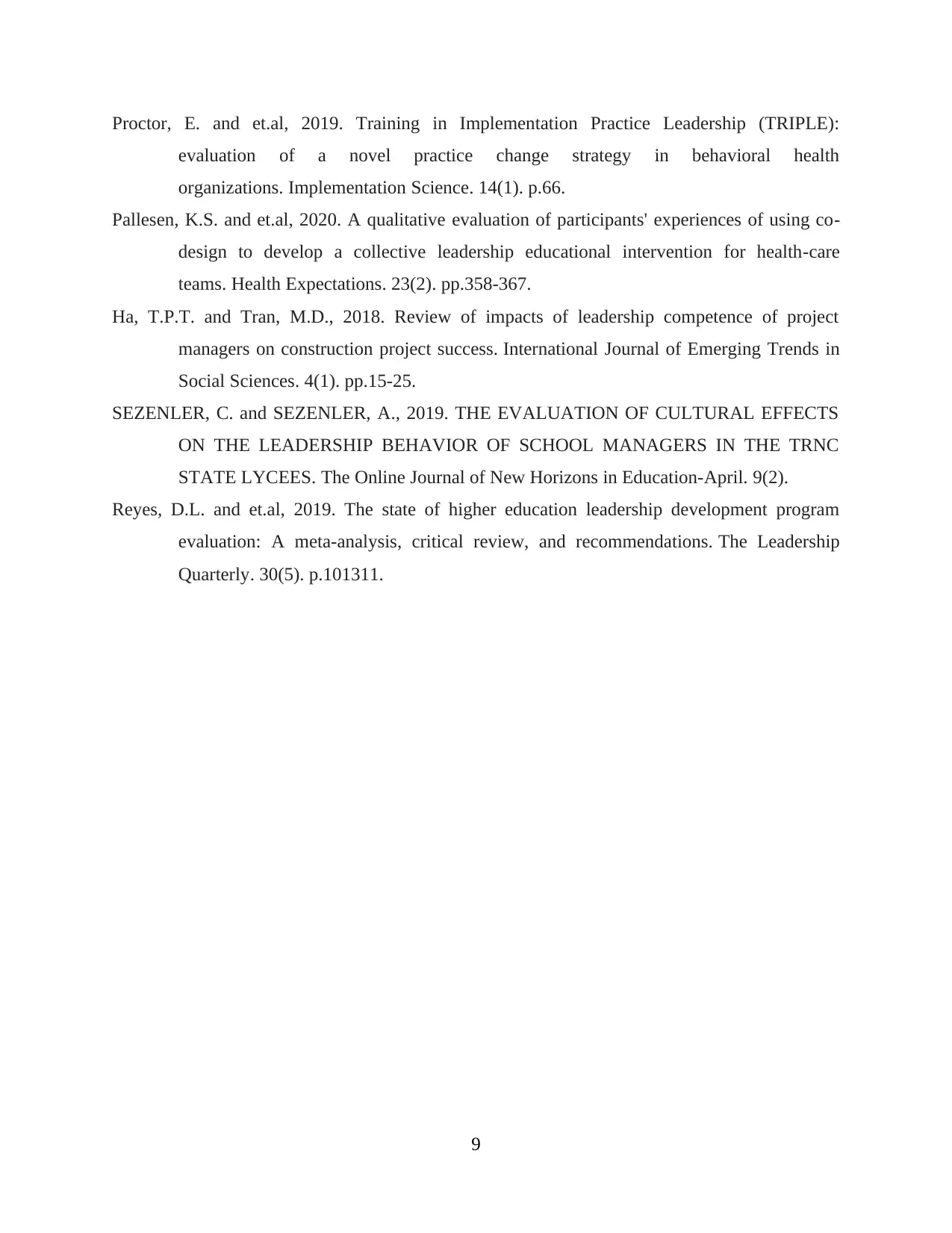
Proctor, E. and et.al, 2019. Training in Implementation Practice Leadership (TRIPLE):
evaluation of a novel practice change strategy in behavioral health
organizations. Implementation Science. 14(1). p.66.
Pallesen, K.S. and et.al, 2020. A qualitative evaluation of participants' experiences of using co‐
design to develop a collective leadership educational intervention for health‐care
teams. Health Expectations. 23(2). pp.358-367.
Ha, T.P.T. and Tran, M.D., 2018. Review of impacts of leadership competence of project
managers on construction project success. International Journal of Emerging Trends in
Social Sciences. 4(1). pp.15-25.
SEZENLER, C. and SEZENLER, A., 2019. THE EVALUATION OF CULTURAL EFFECTS
ON THE LEADERSHIP BEHAVIOR OF SCHOOL MANAGERS IN THE TRNC
STATE LYCEES. The Online Journal of New Horizons in Education-April. 9(2).
Reyes, D.L. and et.al, 2019. The state of higher education leadership development program
evaluation: A meta-analysis, critical review, and recommendations. The Leadership
Quarterly. 30(5). p.101311.
9
evaluation of a novel practice change strategy in behavioral health
organizations. Implementation Science. 14(1). p.66.
Pallesen, K.S. and et.al, 2020. A qualitative evaluation of participants' experiences of using co‐
design to develop a collective leadership educational intervention for health‐care
teams. Health Expectations. 23(2). pp.358-367.
Ha, T.P.T. and Tran, M.D., 2018. Review of impacts of leadership competence of project
managers on construction project success. International Journal of Emerging Trends in
Social Sciences. 4(1). pp.15-25.
SEZENLER, C. and SEZENLER, A., 2019. THE EVALUATION OF CULTURAL EFFECTS
ON THE LEADERSHIP BEHAVIOR OF SCHOOL MANAGERS IN THE TRNC
STATE LYCEES. The Online Journal of New Horizons in Education-April. 9(2).
Reyes, D.L. and et.al, 2019. The state of higher education leadership development program
evaluation: A meta-analysis, critical review, and recommendations. The Leadership
Quarterly. 30(5). p.101311.
9
⊘ This is a preview!⊘
Do you want full access?
Subscribe today to unlock all pages.

Trusted by 1+ million students worldwide
1 out of 13
Related Documents
Your All-in-One AI-Powered Toolkit for Academic Success.
+13062052269
info@desklib.com
Available 24*7 on WhatsApp / Email
![[object Object]](/_next/static/media/star-bottom.7253800d.svg)
Unlock your academic potential
Copyright © 2020–2025 A2Z Services. All Rights Reserved. Developed and managed by ZUCOL.





